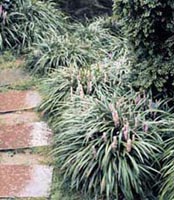Resource Library
Plant of the Week: Liriope (Lilyturf)
The University of Arkansas System Division of Agriculture does not promote, support or recommend plants featured in "Plant of the Week." Please consult your local Extension office for plants suitable for your region.
Plant of the Week
Liriope, Lilyturf
Latin: Liriope muscari

Few plants epitomize the Southern landscape more than the southern magnolia, crapemyrtle
and Liriope. Even before Southern Living magazine became the style guide for the quintessential
"Southern look", Liriope was popular. We see it everywhere -- here as a groundcover,
there bordering a walkway and over yonder edging a flower bed. Southern gardeners
just can’t get enough of this tough, reliable plant.
Liriope - sometimes called "monkeygrass" - is not a grass at all but a member of
the lily family. There are several look-alike plants such as the fast spreading Creeping
Lilyturf (L. spicata) and the less hardy and finer textured Mondograss (Ophiopogon
japonicus) that often confuse gardeners who just have a nodding acquaintance with
these fine plants. Lilyturf is the largest of these, growing 12 to 18 inches tall
- all from half inch wide leaves that push from underground roots. Most of the variegated-leaved
types belong to this species, but uncharacteristically, I prefer the green leafed
form of this plant.
Lilyturf is well behaved in the garden and tends to stay put with the clump slowly
increasing in size. In August plants send up spikes of blue flowers above the foliage
that resemble the unique blue blooms of grape hyacinth - hence the species name. White-flowered
forms are also available. The Creeping Lilyturf also blooms in August but it tends
to keep its flowers hidden down in the foliage and the color is a washed out whitish-blue.
Liriope is originally native to China and Japan and was introduced to the west over
200 years ago. Though it has been around a long time, relatively little has been written
about it in garden books, primarily because Yankee garden writers just don’t understand
our love affair with lilyturf. This species is hardy to Zone 6 in the north while
the Creeping Lilyturf is hardy to Zone 4, but they both do better further south. Just
like alligators and mosquitoes, Liriope likes it hot and humid.
Because of its clump forming nature, lilyturf is a natural for edging or groundcover
purposes. Divisions should be planted on 12 inch centers with two years usually required
for the clump to more or less grow together. Bermudagrass has a bad habit of invading
Liriope plantings, but the relatively new selective grass herbicide called Poast (Ortho
Grass Killer) will kill the bermudagrass without affecting the lilyturf.
While best in moderate shade, lilyturf will grow in either full sun or heavy shade.
Expect fewer flowers in heavy shade. In February the foliage usually dies down to
the ground and should be trimmed off. An easy way to accomplish this is to raise the
wheels on the lawn mower to its highest setting and give it a tall haircut. If you
are tardy about cutting the old leaves back, check to see if new growth is coming
before doing the trim job.
If you wish to divide your plants, early spring is probably the best time but the
plant is tough enough it can be divided at about any season so long as it can be watered.
Once established, lilyturf is tolerant of drought and cold. It does not seem to have
any serious disease or insect problems.
By: Gerald Klingaman, retired
Extension Horticulturist - Ornamentals
Extension News - August 20, 1999
The University of Arkansas System Division of Agriculture does not maintain lists of retail outlets where these plants can be purchased. Please check your local nursery or other retail outlets to ask about the availability of these plants for your growing area.